
Dental-product engineer Dean Reidt began tinkering with the idea of recording deer movements in 1985 and soon launched a new industry. The idea started when Reidt, a bowhunter, was waiting along a deer trail wondering what deer hunters have wondered for generations: How many deer use this trail when I'm not here?
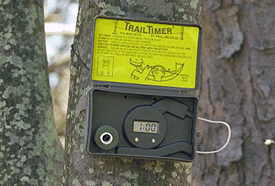
electronic game monitor.
To find out, Reidt placed a digital clock inside a box that could be attached to a tree. He added a string to place across the deer trail and tied the string to a switch closer connected to the clock.
"What I did was turn a digital clock into a stop watch," Reidt said. "When a deer hit the string, the clock would stop. So then I knew what time the deer came through and from which direction."
Reidt called his invention the TrailTimer. It was the first device hunters could use to monitor game movements and the cornerstone of today's constantly evolving game-monitor industry.
Today's devices bear little resemblance to Reidt's TrailTimer. No longer are trip strings used to determine the time an animal passed. Hunters now employ sophisticated cameras that photograph the animal and record time, date and other information. Many types are available, from simple digital cameras to high-tech marvels with all sorts of bells and whistles.
The technology is changing so fast it's hard to keep up with it. But if you're in the market for a trail camera also known as game camera or , this basic buyer's guide can get you started.
Why Use a Game Camera?

only provided the user a visual image of a nice
buck using his hunting area, it also recorded the
date and time the photo was taken, as well as the temperature and moon phase.
Game cameras allow users to scout their hunting areas 24/7 without actually being there. That's a great advantage. After the camera is set up, animals passing in front of its infrared heat-and-motion detector trigger the camera so it shoots a photograph and records pertinent information.
This provides a visual image of the animal so you know its sex, relative age, the time it was using the area and other information that can increase chances for hunting success. A game camera can help you determine if a quality buck is using a scrape; which waterhole is being visited by pronghorns; what time a bear is hitting a bait pile or other facts about your quarry.
A single camera provides lots of useful information, but several cameras placed strategically throughout the area you hunt can be even more helpful. If a big buck is spotted, for example, it can be tracked through the property using the different cameras, which provides an idea of the deer's range. This helps you pinpoint the best places to hunt. As photos are collected, they can be cataloged to provide a record of different animals and their movements so you'll be better prepared when hunting starts.
The biggest advantage of a game camera is it leaves the animals less disturbed. The camera serves as your surrogate "eyes in the woods" and does so much less obtrusively than if you were there. You don't contaminate the area by going in frequently to scout.
Game Camera Factors to Consider Before Buying
Some features make certain cameras more applicable for particular situations than others. The proper selection often depends upon the individual hunter, area and species pursued, but here are features to consider before making a purchase.
The Game Camera's Date/Time Function
For most hunters, this function, which records the date and time a photo was taken, is imperative. Most, but not all, cameras have this feature, so check before buying. Having a photo of a monster buck is nice, but knowing the exact time he came by is what you really need.
Some cameras record additional data as well, including moon phase, temperature, barometric pressure and, as a security measure, the user's name and other identification information. Some cameras also record a GPS geotag that pinpoints the precise location of the camera when a photo is taken.
The Game Camera's Image Resolution for Picture Quality
The term "resolution" refers to the size of the digital images a camera produces and is usually expressed in terms of "megapixels." When comparing cameras, this is one major difference you'll see. For example, the popular Cuddeback Moonlight IR 8 Megapixel Game Camera has a resolution of 8.0 megapixels, RECONYX HyperFire 2 Covert IR Game Camera is a 3 megapixel still shot camera. Some camera brands, such as the Bushnell Trophy Cam HD Game camera range in a variety of resolution choices such as 16, 20, 24 or 30 megapixels.
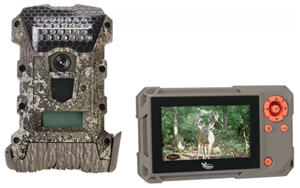
A discussion of resolution can get very technical, but for the sake of discussion here, let's just say that the higher the megapixels, the more detailed and sharper each image will be. And as long as the optics and internal components and software of the camera are the same quality, the larger the image, the higher its quality.
The best way to know whether a game camera takes good pictures is to look at sample pictures from the game cameras you are considering. You might be surprised when you compare a low to a high megapixel image!
If you don't plan to print a lot of photos, this is less important because photos viewed on a computer or TV screen can be smaller and still look good on the monitor. If you want clear, crisp prints to show your buddies, however, you'll be happier with a higher-resolution camera.
Tip: The Wildgame Innovations Wraith 16 Trail Camera delivers 16.0 megapixel pictures or 720p videos in 15-second shots. It also captures great nighttime images and footage using a high-intensity infrared, 28-LED flash that illuminates out to 75' without spooking game. It also comes with a handheld media viewer that allows you to easily retrieve and view your wildlife images and videos.
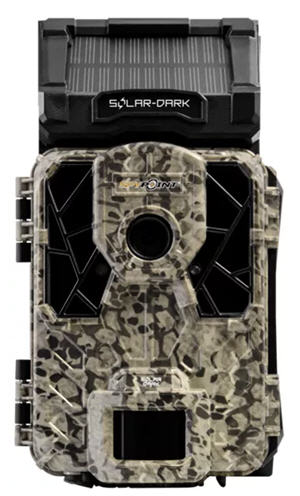
Trail Camera
Here's another factor to consider, one that accounts for variable-resolution choices on some cameras. Larger digital images take up more space in your camera's memory. So if you opt for a 12-megapixel resolution on the SpyPoint SOLAR-DARK Solar Trail Camera, for example, there will be room on the memory card for many more photos, allowing you to return to the camera site less often to download images.
Tip: The SpyPoint SOLAR-DARK Solar game camera captures clear, full-color 12MP images during the day and black-and-white photos at night. Plus, it records 1080p HD video with sound, and you have the option to snap a picture before recording video.
If you opt for a higher megapixel resolution, the photos will be higher quality but the camera can't shoot as many before the memory card is full. Opt for 12-megapixel resolution, and the photos will be of the highest quality but even fewer in number.
Nevertheless, even high-resolution cameras will hold enough photos for general use by hunters in most situations. Many cameras have features where you can choose the megapixel setting allowing you to test your camera for image quality and storage that meets your needs.
As you might expect, higher-resolution and variable-resolution cameras are more expensive than others. If you want decent photos you can print but want to use multiple cameras, you may want to go with a mid-range choice. If capturing high-quality photos of animals you can print and frame for the wall is your goal, then a more expensive high-resolution camera is best.
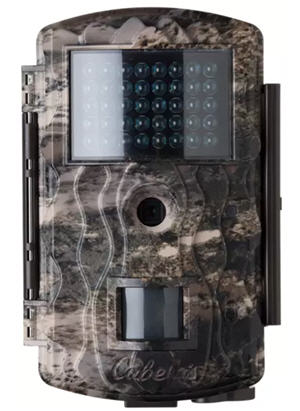
Black IR Game Camera
Tip: Having a trail camera that allows for lower resolutions, as well as high picture resolutions, will allow your SD card to hold more images.
The Game Camera's PIR Angle Width and Range
Many camera descriptions refer to PIR (passive infrared) width and/or range, which refers to the camera's sensing mechanism. The infrared beam on most cameras has a very narrow scope of coverage, usually about 10 degrees. This means an animal must be centered in the field of view for the camera to trigger.
Cameras with a wider PIR angle can sense activity up to 180 degrees, which allows them to capture photos of animals that cross anywhere in front of the camera. Wide-view cameras also are better able to capture pictures of faster-moving animals.
Tip: The Cabela's Outfitter Gen 2 Black IR Game Camera detection range reaches 100' in daylight or 85' at night and the resolution adjusts from 5MP, 8MP to 18MP (still shots).
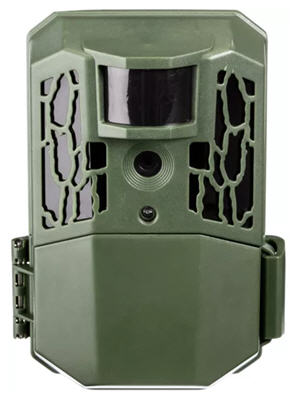
Game Camera
It's also important to note the furthest distance at which a game camera can detect trigger-activating motion, which may range from 30 feet on the low end to 100 feet or more.
Camera Trigger Time - Faster Trigger Speed, More Images
The time that elapses from the moment the camera detects motion until an image is snapped is called trigger time. This can vary from a small fraction of a second on some cameras to as long as 6 seconds on others. While this may seem relatively unimportant, you'll capture many more good images of game animals using a camera with a quick trigger time.
Tip: The Primos Auto Pilot Low Glow Game Camera has a 100' detection range and 0.3-second trigger that won't let fast moving bucks slip by.
The Camera's SD Card Memory
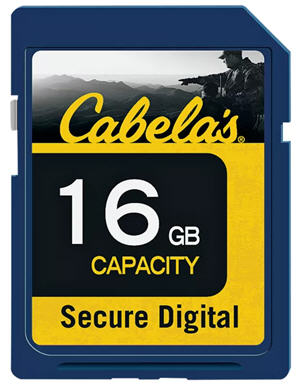
Cards
Almost all game cameras now use removable SD memory cards for photo/information storage. Most cameras have a card included, but if one is not, you'll incur the additional expense of buying one and will need to know the maximum size memory card your camera will accommodate.
Cameras that will accommodate larger-capacity cards — a 32 GB card as compared to an 8 GB card, for example — allow you to store more and higher-resolution images on the camera in the field. A handy accessory now available is a portable handheld viewer like Wildgame Innovations Cloak Pro 14 Game Camera & SD Card Viewer Combo, which allows you to monitor game movements while in the field.
Tip: The Bass Pro Shops and Cabela's Exclusive Wildgame Innovations Cloak Pro 14 Game Camera and SD Card Viewer Combo operates up to 1 year or 30,000 images on a fresh set of 8 AA batteries (not included), and requires an SD card up to 32 GB (not included).
Consider the Trail Camera's Flash Type

Camera
The three main types of flashes for a game camera are; white flash cameras, low glow flash cameras (infrared flash) and not glow flash cameras.
Game cameras use incandescent or infrared (IR) flashes to illuminate the subject in low light and at night. The picture quality of incandescent tends to be far superior to IR, but IR flashes use considerably less battery power, fire much quicker than incandescent flashes and, many hunters say, are less likely to spook animals because the animals can't see them. A few high-end cameras allow changing from IR to incandescent with the flip of a switch, offering the best of both worlds.
Tip: The Bushnell Core No Glow Game Camera utilizes a No Glow infrared flash to reach out 100 feet to give you detailed nighttime images without spooking wary game.
Also important to know is the effective range of the flash, which may vary from 10 to 50 feet or more. A flash with a low range may be OK for photographing animals coming to a wild game feeder or on a trail where the camera can be set at close range, but may produce nothing but the glow of red eyes when photographing animals at a distance in a food plot. Be sure the range will be effective for the area in which you'll be shooting.
Additional Game Camera Features & Accessories to Consider

Among the many additional game camera features you may want to consider are these:
- External LCD: Some models have an LCD display that allows you to check how many pictures have been taken, as well as other stats, without having to open the enclosure or trigger the camera. Built-in viewers that allow previewing your photos also are available.
- TV Jack/Cables: With one of these, can connect directly to a TV to view your photos.
- Intergrated Solar Panel: Some units come with solar panels that charge a built-in rechargeable Lithium battery, So you don't have to worry about running out of power when the bucks are running hot. One example is the top rated SpyPoint Solar 12 Game Camera.
- Aiming Aids: Many units have a test mode or laser aiming device to help aim the camera properly so you won't miss a shot.
- Event Counter: Some units incorporate this feature, which will tell you an animal crossed the sensor beam, even between photos. That way you can get an accurate count of how many times there was activity on a certain trail or area and around what time the activity centered.
- Video: Many cameras now are capable of capturing video (with or without audio, depending on the camera) in addition to photographs. Some only offer fixed-length videos, while others offer programmable video length.
- Multiple Shot/Burst Mode: When this feature is used, the camera will shoot multiple images over a specified time range to capture action that might be missed with a single shot.
- Time-lapse Mode: This feature allows you to set the camera to take images at preset intervals over a period of time, in addition to photos triggered by game.
- Zoom Feature: Depending on the model of camera you have, this allows 2X, 4X or greater magnification for up-close shots of game.
- External Battery Pack: Game cameras usually are powered by standard or rechargeable 9-volt, AA, C or D batteries. If you can't make timely visits to your camera, however, you want to make sure you don't lose battery power between trips. Cameras with an external battery jack can be hooked up to 12-volt batteries for almost unlimited field life. Add a solar charger like the HME Trail Camera 12V/Solar Auxiliary Power Pack and they can run indefinitely.
- Security Features: Game cameras are subject to being stolen or damaged by animals like bears. For this reason, many security features now are incorporated into the designs (camo finish, padlock tabs, password protection, etc.) or are available as accessories (locking bars/brackets, cable locks, security boxes, etc.).
- Wireless Capability: If you don't mind paying the extra cost, you can purchase a wireless camera or an accessory that works with certain cameras that will transmit images to your personal computer or the Internet for off-site viewing. These eliminate the need to travel to or through your hunting area to retrieve camera images, creating less disturbance and saving time and money. SpyPoint CELL-LINK Universal Cellular Adapter, for example, will convert your non-cellular trail camera with a standard SD card slot into a wireless, cell-enabled camera. The CELL-LINK uses your camera's SD card slot to access the images, and wirelessly sends them to the Spypoint smartphone app, allowing you to view images and videos from virtually anywhere!
- Special Features: As game cameras evolve, more special features become available such as the built-in programmable game calls (deer, turkey, moose, elk and predators) that attract animals. Expect to see more exciting innovations in the future.
Once you use a game camera, you will never want to scout without one again. Imagine being able to keep tabs on a favorite rub, waterhole or hot bear bait day in and day out, even when you're working. Game cameras allow you to do all that and more, helping you know more about your quarry so you have a greater chance of success on all your hunts.
- 14501 views

